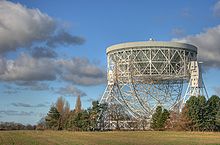Jodrell Bank Observatory
The Jodrell Bank Observatory a radio telescope in Cheshire. It picks up radio waves from outer space. Jodrell Bank is mainly used for investigating radio waves from the planets and stars.
 | |
| Alternative names | Jodrell Bank Experimental Station |
|---|---|
| Named after | William Jauderell |
| Organization | University of Manchester |
| Location | Lower Withington, United Kingdom |
| Coordinates | 53°14′10″N 2°18′26″W / 53.23625°N 2.3071388888889°W |
| Altitude | 77 m (253 ft) |
| Established | 1945 |
| Website | www |
| Telescopes | 42ft radio telescope of Jodrell Bank Observatory 7m radio telescope of Jodrell Bank Observatory Cambridge MERLIN telescope Darnhall telescope Defford telescope Knockin telescope Lovell Telescope Mark II Mark III Pickmere telescope Polar Axis telescope Searchlight Telescope Transit Telescope mERLIN |
| Location | United Kingdom |
| Criteria | Cultural: (i), (ii), (iv), (vi) |
| Reference | 1594 |
| Inscription | 2019 (43rd Session) |
| Area | 17.38 ha (42.9 acres) |
| Buffer zone | 18,569.22 ha (45,885.5 acres) |
It was the idea of its first director, Bernard Lovell, to use radio signals to investigate cosmic rays. Lovell, Professor of Astronomy at Manchester University, had worked on radar in World War II. The observatory was set up in 1945.
It has been used to research meteoroids, quasars, pulsars, masers and gravitational lenses. It was heavily involved in tracking space probes.
The main telescope at the observatory is the Lovell Telescope. It has a diameter of 250 ft (76 m), and is the third largest steerable radio telescope in the world. There are three other active telescopes at the observatory.
The Jodrell Bank Observatory is the base of the Multi-Element Radio Linked Interferometer Network (MERLIN), a "National Facility" run by the University of Manchester. What this means is that radio telescopes can work together to form a long baseline to better collect data from an important phenomenon. There are three other active telescopes at the observatory; the Mark II, and 42 ft (13 m) and 7 m diameter radio telescopes.
The telescope discovered radio noise from the Great Nebula in Andromeda—the first definite detection of an extragalactic radio source—and the remains of Tycho's Supernova in the radio frequency. At that time, Tycho's Supervova had not been discovered by regular light telescopes.[1]
References
change- ↑ "The early history". Jodrell Bank Observatory. Archived from the original on 27 October 2008. Retrieved 22 November 2006.
